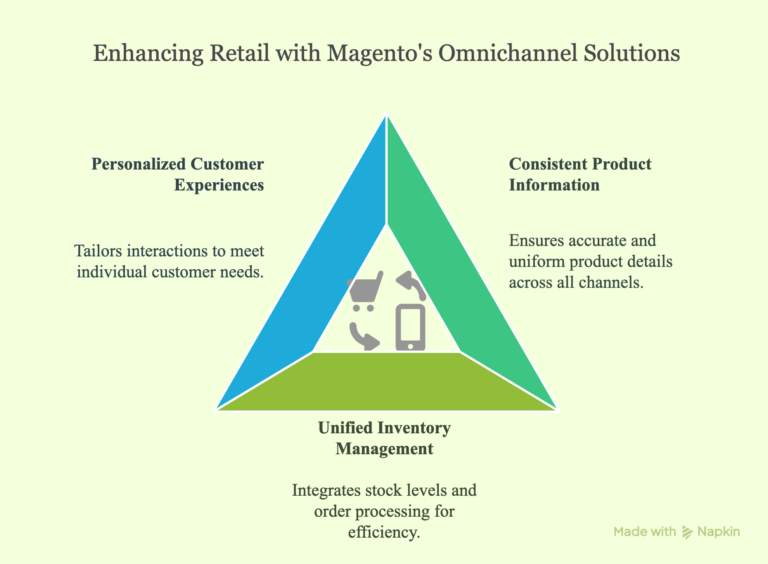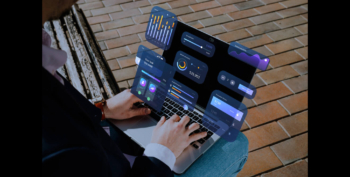Greetings! I'm Aneesh Sreedharan, CEO of 2Hats Logic Solutions. At 2Hats Logic Solutions, we are dedicated to providing technical expertise and resolving your concerns in the world of technology. Our blog page serves as a resource where we share insights and experiences, offering valuable perspectives on your queries.

Quick Summary
Headless Magento separates the frontend presentation layer from the backend commerce functionality, enabling true omnichannel experiences across all customer touchpoints. Its API-first architecture (REST, GraphQL) allows businesses to deliver consistent product information, unified inventory management, and personalized experiences across web, mobile, in-store kiosks, and emerging channels. Implementation requires careful planning but yields significant benefits: faster time-to-market, improved customer experiences, and future-proof architecture. Challenges include performance optimization, search functionality, content management, and cross-channel analytics, all solvable with proper implementation strategies.
Have you ever been frustrated when a customer abandons their cart because they can’t seamlessly switch from browsing on mobile to completing checkout on desktop?
Or perhaps you’ve struggled to update product information across multiple sales channels without duplicating effort?
If these scenarios sound familiar, you’re experiencing the limitations of traditional commerce platforms in an increasingly omnichannel world.
At 2Hats Logic, we’ve helped dozens of brands overcome these exact challenges. Let us tell you, Magento’s headless capabilities offer a powerful solution.
What Is Headless Commerce and Why Does It Matter?
Headless commerce separates the frontend presentation layer (the “head”) from the backend commerce functionality.
This decoupling enables businesses to deliver consistent, personalized experiences across multiple touchpoints while managing all commerce operations from a single backend.
This architecture unlocks tremendous flexibility and scalability for Magento users that traditional monolithic systems simply can’t match.
Ready to transform your customer experience with headless Magento?
Traditional vs. Headless Magento: Key Differences
| Feature | Traditional Magento | Headless Magento |
|---|---|---|
| Architecture | Tightly coupled frontend and backend | Decoupled frontend and backend |
| Channel Support | Primarily web-focused | Any channel (web, mobile, IoT, kiosks, etc.) |
| Frontend Technology | Theme-based, PHP templates | Any frontend tech (React, Vue, Angular, etc.) |
| Development Speed | Slower iterations, more dependencies | Faster development cycles, independent teams |
The Technical Foundation of Headless Magento
Magento’s headless capabilities are built upon its robust API architecture, which has evolved significantly since the introduction of Magento 2.
Core APIs That Enable Headless Implementation
- REST API: Supports standard CRUD operations and provides a straightforward way to interact with Magento’s backend.
- GraphQL API: Introduced in Magento 2.3, GraphQL allows for more efficient data retrieval by enabling clients to request exactly what they need in a single query.
- PWA Studio: Magento’s toolkit for building Progressive Web Applications, which includes:
- Peregrine (React components)
- Venia (reference storefront)
- UPWARD (server middleware)
- Buildpack (configuration and build tools)
Pro-Tip: When implementing headless Magento, start by mapping out all your customer touchpoints and their specific requirements before selecting frontend technologies. This approach ensures you’re building a solution that truly addresses your omnichannel needs rather than just implementing headless for its own sake.
How Magento Enables True Omnichannel Experiences
Omnichannel isn’t just about being present on multiple channels,it’s about creating a unified, consistent experience across all touchpoints.
Here’s how Magento’s headless architecture makes this possible:

1. Consistent Product Information Management
With headless Magento, your product catalog becomes a centralized source of truth. Update a product description, price, or availability once, and that change propagates across all channels automatically.
For instance, when we helped a fashion retailer implement headless Magento, they reduced their product update time by 78% while eliminating inconsistencies that had previously led to customer confusion and support calls.
2. Unified Inventory and Order Management
Magento’s Order Management System (OMS) integrates seamlessly with its headless architecture to provide real-time inventory visibility across channels.
This enables powerful omnichannel capabilities such as:
- Buy online, pick up in store (BOPIS)
- Ship from store
- Return anywhere
- Cross-channel gift cards and loyalty programs
3. Personalized Customer Experiences
By leveraging Magento’s customer data platform alongside its headless capabilities, you can deliver highly personalized experiences across channels based on:
- Purchase history
- Browsing behavior
- Location
- Device preferences
- Loyalty status
Ready to unify your customer experience across all channels?
Real-World Implementation Strategies
Moving from theory to practice, here’s how to successfully implement headless Magento for omnichannel commerce:
Phase 1: Assessment and Planning
Before writing a single line of code, conduct a thorough assessment:
- Channel Audit: Document all existing and planned customer touchpoints
- Technical Inventory: Catalog your current systems, integrations, and data flows
- Experience Mapping: Create journey maps to identify cross-channel scenarios
- KPI Definition: Establish clear metrics to measure implementation success
Phase 2: Architecture Design
Based on your assessment, design your headless architecture:
- API Strategy: Decide between REST, GraphQL, or a hybrid approach
- Frontend Selection: Choose appropriate frontend technologies for each channel
- Integration Framework: Design how Magento will connect with other systems
- Caching Strategy: Plan for performance optimization
Phase 3: Implementation Approach
We typically recommend a phased approach to headless implementation:
- Start with a Pilot Channel: Rather than transforming everything at once, begin with a single channel (often mobile or a new channel)
- Establish Core APIs: Build and test fundamental API connections
- Implement Cross-Channel Use Cases: Gradually add omnichannel capabilities
- Scale and Optimize: Expand to additional channels while refining performance
When we helped a B2B manufacturer implement headless Magento, we started with their dealer portal before expanding to their consumer-facing website and field sales app. This approach reduced risk while allowing the team to learn and adjust.
Pro-Tip: Create a dedicated API development environment separate from your production Magento instance. This allows frontend teams to develop against stable API versions while backend teams continue enhancing the core platform.
Need a tailored implementation plan for your headless Magento project?
Common Challenges and Solutions
While headless Magento offers tremendous omnichannel benefits, implementation isn’t without challenges:
Challenge 1: Performance Optimization
Problem: API-driven architectures can introduce latency compared to monolithic systems.
Solution: Implement a robust caching strategy using:
- Varnish for full-page caching
- Redis for application caching
- CDN integration for static assets
- Client-side state management
Challenge 2: Search Functionality
Problem: Native Magento search may not meet the needs of headless implementations.
Solution: Integrate with specialized search services like:
- Elasticsearch (now included with Magento Commerce)
- Algolia
- Constructor.io
Challenge 3: Content Management
Problem: Magento’s native CMS has limitations for complex omnichannel content needs.
Solution: Integrate with a headless CMS like:
- Storyblok
- Adobe Experience Manager
This creates a “best of breed” approach where Magento handles commerce while the CMS manages content across channels.
Challenge 4: Analytics and Insights
Problem: Tracking customer journeys across decoupled channels can be difficult.
Solution: Implement a unified analytics approach using:
- Data layer standardization
- Cross-channel user identification
- Customer data platform integration
Future-Proofing Your Omnichannel Strategy with Headless Magento
The commerce landscape continues to evolve rapidly. Here’s how headless Magento positions you for future omnichannel innovations:
1. Emerging Channels
As new customer touchpoints emerge from voice commerce to augmented reality shopping, headless Magento allows you to add these channels without rebuilding your commerce core.
2. Composable Commerce
The headless approach aligns perfectly with the emerging “composable commerce” paradigm, where businesses assemble best-of-breed components rather than relying on all-in-one solutions.
3. API-First Ecosystem
Adobe’s continued investment in Magento’s API capabilities ensures you’ll have access to expanding functionality through standardized interfaces.
Case Study: Multi-Brand Retailer Transforms with Headless Magento
One of our clients, a retailer with multiple brands and over 200 physical locations, faced significant challenges with their traditional Magento implementation:
- Inconsistent shopping experiences across web, mobile, and in-store
- Slow time-to-market for new features (8+ weeks on average)
- Difficulty supporting brand-specific frontend experiences on a shared backend
- Limited ability to personalize based on channel preferences
By implementing headless Magento with our guidance, they achieved:
- 43% faster mobile page load times
- 27% increase in mobile conversion rate
- 65% reduction in time-to-market for new features
- 18% growth in cross-channel customer lifetime value
The key to their success was a phased approach that prioritized high-impact customer journeys while gradually expanding their headless capabilities.
Getting Started with Headless Magento
If you’re considering headless Magento for your omnichannel strategy, here are the practical next steps:
- Assessment: Evaluate your current Magento implementation and omnichannel readiness
- Proof of Concept: Develop a small-scale prototype focused on a specific channel or customer journey
- Roadmap Development: Create a phased implementation plan aligned with business priorities
- Team Preparation: Ensure you have the right skills and resources (or partners) for both frontend and API development
Pro-Tip: When budgeting for headless Magento, remember to account for both the initial implementation and the ongoing operational benefits. While headless projects typically require more upfront investment, they often reduce total cost of ownership through faster updates, greater reuse, and improved business outcomes.
Conclusion: Embracing the Headless Future
Magento’s headless capabilities provide a powerful foundation for true omnichannel commerce.
The businesses that thrive in tomorrow’s commerce landscape will be those that can seamlessly blend digital and physical interactions into cohesive customer journeys.
At 2HatsLogic, we’ve helped dozens of brands transform their customer experience with headless Magento implementations.
Ready to explore how headless Magento can transform your omnichannel strategy? Contact our team for a personalized consultation.
FAQ
What is headless Magento for omnichannel?
Headless Magento separates frontend interfaces from backend commerce functions. This allows businesses to deliver consistent shopping experiences across web, mobile, in-store, and IoT touchpoints while managing all operations from a single backend system.
What are the main benefits of headless Magento for omnichannel?
Key benefits include consistent product information across all channels. Unified inventory management, personalized customer experiences, faster time-to-market for new features, and future-proofing your commerce architecture for emerging channels.
What technical components enable headless Magento?
Magento's omnichannel capabilities are powered by its REST API, GraphQL API, and PWA Studio toolkit. Which together provide the foundation for connecting multiple frontend experiences to a unified commerce backend.
Table of contents
- What Is Headless Commerce and Why Does It Matter?
- Traditional vs. Headless Magento: Key Differences
- The Technical Foundation of Headless Magento
- How Magento Enables True Omnichannel Experiences
- Common Challenges and Solutions
- Future-Proofing Your Omnichannel Strategy with Headless Magento
- Getting Started with Headless Magento
- Conclusion: Embracing the Headless Future

Related Articles






